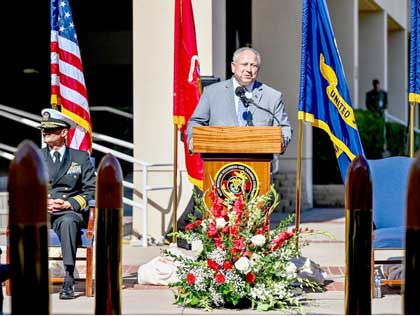 Secretary of the Navy Carlos Del Toro announced that a future Bethesda-class expeditionary medical ship will be named USNS Balboa (EMS 2), during a ceremony at Naval Medical Center San Diego, Oct. 27. The future USNS Balboa honors the legacy and commitment of Navy doctors, nurses, corpsmen, and staff of Balboa Naval Hospital in caring for the needs of U.S. Service Members. U.S. Navy photo by CPO Shannon Renfroe.
Secretary of the Navy Carlos Del Toro announced that a future Bethesda-class expeditionary medical ship will be named USNS Balboa (EMS 2), during a ceremony at Naval Medical Center San Diego, Oct. 27. The future USNS Balboa honors the legacy and commitment of Navy doctors, nurses, corpsmen, and staff of Balboa Naval Hospital in caring for the needs of U.S. Service Members. U.S. Navy photo by CPO Shannon Renfroe.
SECNAV Del Toro names future medical ship USNS Balboa (EMS 2)
Secretary of the Navy Carlos Del Toro announced today that a future Bethesda-class expeditionary medical ship will be named USNS Balboa (EMS 2), during a ceremony at Naval Medical Center San Diego, Oct. 27.
The future USNS Balboa honors the legacy and commitment of Navy doctors, nurses, corpsmen, and staff of Balboa Naval Hospital in caring for the needs of U.S. Service Members.
“The contributions of this medical center over the past 100 years, represented by the care its personnel delivers to our Sailors, Marines, and families, are absolutely incredible. This hospital’s personnel continue to conduct ground-breaking medical research, discover new and innovative approaches to the delivery of world-class medical care, and provides a medical residency program for over a dozen medical specialties to develop our next generation of military doctors,” said Secretary Del Toro. “The guiding principle of Navy Medicine is to align its people and platforms in order to enhance warfighter health, wellness, and performance. I can say, with full confidence, that Naval Medical Center San Diego achieves this on a daily basis.”
The name selection follows the tradition of naming expeditionary medical ships after U.S. military hospitals.
As the informal name for Naval Medical Center San Diego, “Balboa” began as a naval hospital tent erected in December 1914 in support of the Panama-California Exposition (1915–1917) held in San Diego’s Balboa Park. When the United States entered World War I, the Navy converted the deserted exposition grounds into a training center containing a war dispensary and a camp hospital. In September 1919, San Diego officials set aside 17.35 acres of the park at Inspiration Point for the construction of a permanent naval hospital, often referred to as the “Pink Palace,” for its stucco façade. Commissioned in 1922, the complex added a hospital corpsman school in 1928 and continued to grow throughout World War II, the Korean War, and the Vietnam War, adding a surgical building, medical library, and outpatient clinic over time. By the early 1970s, the Balboa complex was among the largest military hospitals in the world. A new hospital compound to replace aging structures was completed in 1988 on land adjacent to Inspiration Point with the former site reverting to the City. Today, Balboa leads the way as one of the largest naval medical teaching and research facilities in the nation, in addition to supporting five medical mobilization teams and USNS Mercy (T-AH 19).
In addition, Secretary Del Toro announced that Mrs. Deborah Paxton, MSN, RN, agreed to be the ship’s sponsor. Mrs. Paxton, wife of retired Marine Corps General John Paxton, the 33rd Assistant Commandant of the Marine Corps, has spent her life in support of the Marine Corps and a decade of work serving the Marine Corps’ Wounded Warrior Regiment as the mental health advisor to the regiment.
“I am beyond grateful that Secretary Del Toro chose me for this great honor, and I pledge my commitment to USNS Balboa and her crew,” said Deborah Paxton. “I feel such confidence and comfort knowing that EMS 2 will operate where Marines and Sailors are engaged in either combat or humanitarian relief providing access to world-class medical care in critical times.”
Bethesda-class expeditionary medical ships are designed as a dedicated medical ship that optimizes hospital-level medical care in support of distributed maritime operations (DMO). EMS will feature a shallow draft enabling greater reach and allowing direct access to shallow austere ports, while also providing a flight deck that accommodates military helicopters. This design provides a full range of medical capabilities including triage/critical care, three operating rooms, medical laboratory, radiological capability, blood bank, dental, mental health, OB/GYN and primary care, rapid stabilization and follow-on evacuation of multiple casualties and combat search and rescue including recovery at sea. The primary mission of the EMS as a high-speed forward-deployed medical ship is to provide rapid responsive sea-based and near-shore hospital level critical care, humanitarian assistance, disaster relief, non-combatant evacuation operations and special operations. The EMS is designed to respond and provide care at a more rapid pace than their predecessors, USNS Mercy and USNS Comfort, sailing at speeds of at least 30 knots with a range of 5,500 nautical miles at 24 knots.
Military News | Navy News | Hospital ship to be USNS Balboa


